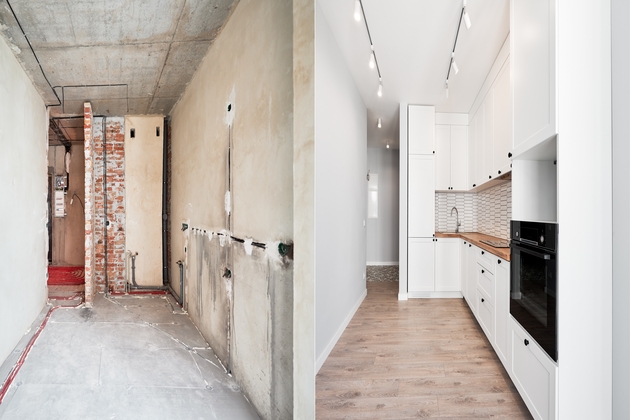Guide to Selling a House That Needs Repairs: How to Sell a Home That Needs Work?
October 3rd, 2025 / Author: Cesar GomezYou’ve inherited a family home that’s been lived in for decades. The roof has seen better days, the carpet is stained, the plumbing is questionable, and you’re already overwhelmed before you even think about listing it. Or maybe you’re relocating for work and simply don’t have the time (or the cash) to get your house market-ready. You might even be living in the home yourself, but years of small problems have added up into something that feels impossible to fix.
Many homeowners find themselves holding onto a property that needs more repairs than they can handle. Repairs cost money, take time, and often come with surprises. But selling a house that needs repairs is completely doable – and you don’t have to give it away or sink thousands into renovations just to move forward.
This guide will walk you through what selling a home that needs work really means, how to weigh your options, and why selling as-is, especially to a trusted local cash buyer like SleeveUp Homes, might be your best path to a fair, fast, and stress-free sale. With the right strategy, you can still walk away with a solid deal, cash in hand, and peace of mind.
Assessing the Condition: Can You Sell Your House If It Needs Repairs?
.jpg)
Absolutely — and that’s one of the most common questions homeowners ask when they feel overwhelmed by a long repair list. The short answer is yes, you can sell your house if it needs repairs. The longer answer is that how you sell it depends on your goals, your timeline, and your financial situation.
When people say they’re selling a house that needs repairs, they’re not always talking about the same thing. For some, it’s just cosmetic repairs – peeling paint, worn carpet, outdated window treatments – things you could fix in a weekend for a few hundred dollars. On the heavy end, you’re staring down an outdated electrical system or load-bearing wall damage that threatens the structural integrity of the home, which can stretch into the tens of thousands of dollars.
Labor and material costs have gone up sharply in recent years. According to HomeAdvisor, the average cost of home repairs in 2025 was $52,236.
- Minor cosmetic repairs: fresh paint, landscaping, new fixtures. Usually costs a few hundred to a few thousand dollars.
- Moderate issues: water damage from roof leaks, plumbing problems, outdated kitchen/bath, and flooring replacement. Can easily run $10,000–$25,000.
- Major structural or safety concerns: foundation cracks, electrical rewiring, mold remediation, building codes violations. These can hit $50,000+.
The key is being honest about where your house falls on that spectrum. A home with cosmetic repairs is one thing. A house with serious safety issues is another. If you’re unsure, the best first step is to get a professional opinion. Here are some ways to get a sense of the repair bill:
- Pre-listing inspection: Can cost a few hundred dollars, but it gives you an inspection report that lays out the real issues.
- Contractors can also provide estimates for major repairs.
- DIY research: If you’re just curious, we show you how you can roughly calculate how repairs might affect your home’s value below.
Once you know the scope, you can make a smart decision about how to move forward.
How Much to Offer on a House that Needs Work?
Knowing how to price a home that needs repairs really depends on two things: the home’s market value if it were in good condition, and the cost of repairs needed to bring it up to that level.
- Start with the after-repair value (ARV) – What the home would likely sell for once it’s fixed up. You can get a ballpark number from a comparative market analysis, an online home value estimator, or by looking at similar updated homes in the neighborhood.
- Subtract the estimated repair costs.
- Factor in transaction costs and risk – Buyers typically subtract another 10–20% to cover closing costs, holding costs, and the risk that repairs could run higher than expected.
Here’s an example:
A fully updated home in the area sells for $400,000 (that’s your ARV). Repairs are estimated at $50,000. Subtract another $30,000–$40,000 for transaction costs, profit margin, and risk. That means a fair offer might land around $310,000–$320,000.
Deciding Strategy: Selling As-Is vs. Making Repairs

Here’s the million-dollar question: Should you fix the problems, or sell the home as-is? Most buyers expect a home to have at least a few issues. But when the problems are bigger, traditional buyers may hesitate, lenders may require fixes before approving financing, and your pool of potential buyers shrinks.
That doesn’t mean you’re stuck. It just means you need the right strategy.
- Sell as-is – You don’t make repairs, and sell the property in its current condition. Cash buyers and property investors are most likely to step in here, because they don’t rely on banks and aren’t scared off by an inspection report.
- Make selective repairs – If you’ve got the budget, tackling safety concerns or big-ticket items can open the door to more traditional buyers and higher offers.
- List with transparency – Even if you can’t afford repairs, you can still list on the open market. Just be prepared to price the home realistically, follow disclosure laws, and negotiate repair credits or concessions with the buyer.
Option 1: Selling Your Home As-Is
Selling a house as-is means you’re upfront that you’re not making repairs. What the buyer sees is what the buyer gets. For many homeowners, this route is the most straightforward. You don’t have to schedule contractors, spend weeks living in chaos, or front tens of thousands of dollars in the hope you’ll earn it back at closing.
Who buys homes as-is? Actually, quite a few people:
- Cash buyers like SleeveUp Homes, who specialize in buying properties in any condition directly from homeowners with no middlemen involved.
- Property investors and home flippers looking for their next project.
- DIY buyers who want a fixer-upper and are willing to put in sweat equity.
The biggest advantage here is speed and certainty. When you work with a cash buyer, you don’t have to worry about a buyer’s loan falling through, inspection contingency drama, or whether the appraiser agrees with the listing agent’s pricing.
Option 2: Making Strategic Repairs
Some sellers want to put in a little work to squeeze out a higher home sale price. If you decide to take this route, the goal isn’t to renovate every square inch, but focus on a few targeted fixes and issues that affect safety, habitability, or first impressions.
Homes in need of work change hands every single day. The key is knowing which repairs are deal-breakers, which ones you can skip, and whether a direct sale to a cash buyer will get you where you want to go faster.
Bigger Home Fixes Worth Spending On
Some repairs aren’t cheap fixes, but they’re tied directly to safety, habitability, and whether your home even meets local building codes.
- Roof leaks or foundation cracks, such as load-bearing wall damage.
- Plumbing problems – outdated or damaged pipes can cause leaks, water damage, and even health hazards from mold or contaminated water.
- Electrical system issues – old wiring or overloaded panels are fire hazards and often violations of building codes.
- Pest infestations – termites, rodents, or other pests can compromise both safety and structure, and disclosure laws require you to inform buyers.
Easy Cosmetic Updates
Even relatively small updates can go a long way without draining your wallet. These fixes don’t address deep issues, but they do help buyers see the potential of the property instead of being distracted by surface flaws. Think of it as polishing up the home so it puts its best foot forward.
- A fresh coat of paint – Easy and cost-effective. Stick with neutral colors like soft grays, warm whites, or beige tones that give a “fresh canvas” look.
- Flooring refresh – replacing stained carpet or outdated vinyl with affordable laminate or new carpet makes rooms feel cleaner and newer.
- Minor cosmetic repairs – Little fixes that don’t cost much but make a big difference. Patch small holes in the wall. Replace broken light fixtures or faucets. Tighten squeaky doors.
- Curb appeal – Look up DIY landscaping ideas. Mow the lawn, trim the bushes, and maybe add a few inexpensive plants by the entryway or outdoor lighting to brighten the entrance.
- Virtual staging – If the idea of staging feels overwhelming, consider virtual staging. It’s affordable and lets buyers imagine the home’s potential without you spending thousands on furniture.
How to Decide
At the end of the day, it comes down to your preferences. If you can afford a few upgrades and have the time to manage them, strategic repairs might make sense. But if your main goal is to move quickly and avoid pouring money into the house, selling as-is is usually the smarter move. Ask yourself:
- Do you have the budget and time for repairs?
- What do local market conditions look like? In a hot market, selling as-is might net almost as much as a fully renovated property.
- What’s your stress tolerance? Some people just want out quickly.
Mistakes That Can Cost You
Selling a house that needs repairs is a balancing act. There are a few common mistakes you’ll want to avoid.
- Over-investing in renovations: It’s tempting to think, “If I just redo the kitchen, I’ll get top dollar.” But in reality, a $30,000 remodel might only add $20,000 in value. Market trends and market standards dictate what buyers will pay—not your renovation receipts.
- Hiding problems: Federal and state laws require sellers to disclose known issues. Whether it’s pest infestations, water damage, or foundation cracks, trying to sweep them under the rug will only backfire. Disclosure requirements and legal obligations exist for a reason. If a buyer discovers undisclosed issues later, you could face lawsuits.
- Pricing too high: It’s easy to be optimistic, but buyers are looking at comparative market analysis reports, home inspection results, and the overall market dynamics. If you’re way out of line, your house will sit.
- Ignoring current market conditions: In a hot market, even fixer-uppers can attract multiple offers. In a slower market, buyers will expect concessions.
Negotiating & Handling Offers

Let’s say you’ve listed the home, and offers are starting to come in. What now?
- Expect buyers to ask for a home inspection.
Be ready. Most traditional buyers want an inspection contingency that allows them to renegotiate or walk away if major problems come up. This is where having an inspection report or contractor estimates in hand can help you control the conversation.
- Know your limits.
If a buyer comes in with a low offer, don’t panic. Counter with data. Decide ahead of time which repairs or credits you’ll offer, and explain how you priced them accordingly.
But here’s where things often stall. Traditional buyers can get cold feet after an inspection, especially if they’re not prepared for major updates. Plus, every negotiation eats up time. That’s one of the reasons more sellers are turning to cash buyers for the simplicity of a direct cash sale.
Why Selling As-Is to a Cash Buyer Is the Smartest Move for Properties that Need Work
If you’re tired just reading about inspections, repairs, and negotiations, you’re not alone. Many homeowners find that selling as-is to a cash buyer is the most straightforward solution for selling a home that needs repairs and maximizing profit without huge investments.
Here’s why it works:
- No listing agent commissions eating into your profits (5–6% saved).
- No closing costs (some cash buyers like SleeveUp cover them).
- No hidden fees or additional transaction costs from drawn-out negotiations or deals falling apart at the last minute. You close on your schedule.
- No inspection contingency drama—as-is home buyers don’t back out over repair surprises.
Still, many homeowners worry about being lowballed when selling a house that needs repairs as-is. That’s where trust matters. At SleeveUp Homes, our offers are transparent, based on real market value, local market trends, and a clear understanding of the property—not guesswork.
In fact, we guarantee we’ll beat any legitimate offer by $10,000. That’s not a sales gimmick. It’s our way of proving we’re serious about fair, transparent deals.
How to Prepare for an As-Is Sale: Getting Your Home Ready Without Breaking the Bank
.jpg)
The beauty of an as-is home sale? You don’t have to invest a dime. But even if you’re selling a home that needs repairs, presentation matters. A clean, well-presented house always sells faster than a messy one, no matter the condition.
- Declutter and clean. Get rid of stacks of mail, outdated furniture, and personal items. It helps buyers and investors see potential, and that’s hard to do when every corner is filled.
- Gather paperwork like inspection reports, repair estimates, and utility bills.
- Be honest about the property’s condition. As-is property buyers expect problems. Being upfront does nothing but save time and build trust.
That's all you need to sell a house that needs repairs as-is, fast.
Why SleeveUp Homes Is the Best Option for Selling a House As-Is
When you work with SleeveUp Homes, you invest minimal effort and get maximum return. Here’s exactly what you can expect:
- You reach out and request an offer. We do a quick property assessment—no long showings, no open houses.
- Get a fair cash offer on the spot: No lowballing. We even guarantee $10,000 more than any other legitimate offer.
- Skip the headaches: No listing agents, no repair negotiations, no waiting for financing approvals. We cover the closing costs and handle all the paperwork.
- Close on your schedule: You decide when to close, whether that’s in as little as 7 days or later if you need flexibility.
- Walk away with cash in hand – fast, secure, and stress-free.
We’re not a faceless corporation. We’re trusted Southern California local cash buyers. We know the neighborhoods, the market dynamics, and the building codes. And most importantly, we know what it’s like to feel stuck with a house you no longer want that needs work. Our job is to help you move forward with ease, confidence, and what you deserve.
How to Sell a House that Needs Repairs? Get in Touch with Us
Selling a home that needs an upgrade doesn’t have to feel like climbing a mountain. You don’t have to empty your savings account on renovations or stress over buyers backing out at the last minute. If you’re trying to decide how to sell a house that needs repairs and weighing the pros and cons of making updates, you have options.
The traditional route with renovations and a listing agent might make sense if you’ve got time and money to invest. But for many homeowners, the as-is home sale route with a trusted local cash buyer like SleeveUp Homes offers the perfect balance of fairness, speed, and peace of mind. You deserve a solution that makes your life easier, not harder. And that’s exactly what we’re here to provide.
Request a free, no-obligation cash offer for your property today, and we'll make sure you walk away with what you deserve.
SELL
YOUR HOUSE
If you want to sell fast and are worried about how long the traditional process takes, and the commission and fees involved, consider working with SleeveUp Homes.





 view all blogs by this author
view all blogs by this author Zachariah Peterson (69 blogs)
Zachariah Peterson (69 blogs)